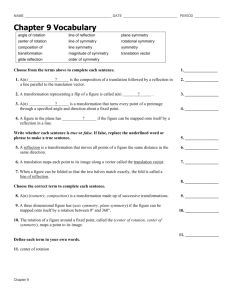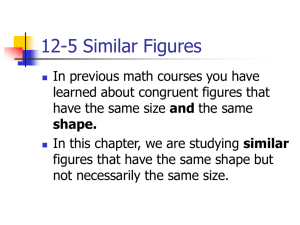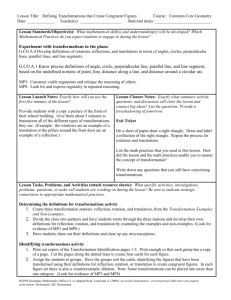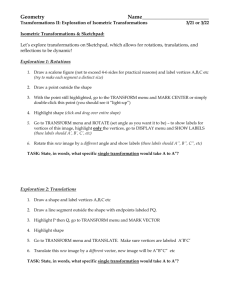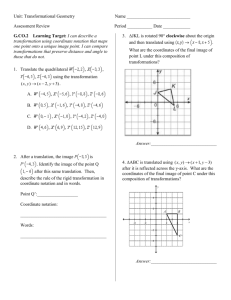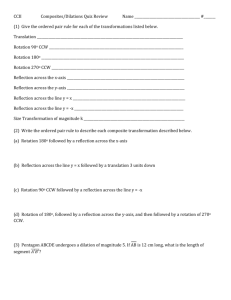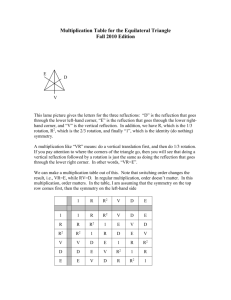Transformations
advertisement
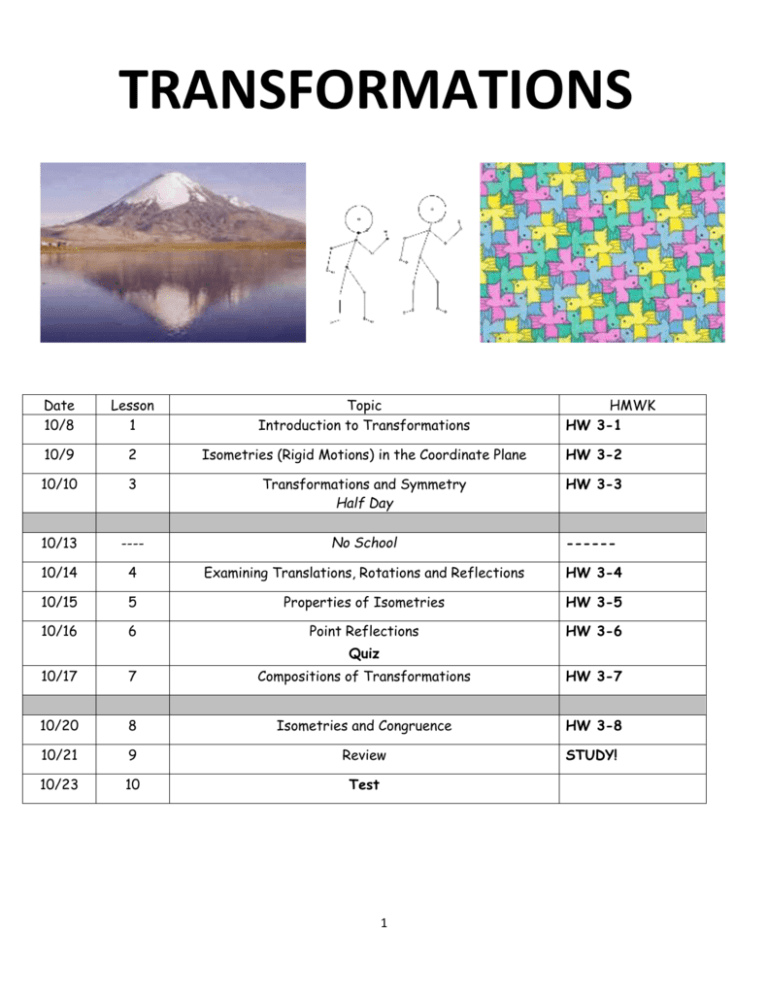
TRANSFORMATIONS Date 10/8 Lesson 1 Topic Introduction to Transformations HMWK HW 3-1 10/9 2 Isometries (Rigid Motions) in the Coordinate Plane HW 3-2 10/10 3 Transformations and Symmetry Half Day HW 3-3 10/13 ---- No School ------ 10/14 4 Examining Translations, Rotations and Reflections HW 3-4 10/15 5 Properties of Isometries HW 3-5 10/16 6 Point Reflections HW 3-6 Quiz 10/17 7 Compositions of Transformations HW 3-7 10/20 8 Isometries and Congruence HW 3-8 10/21 9 Review STUDY! 10/23 10 Test 1 Day 1 Notes Goal: Connect student knowledge about functions (input/output process) and equations to transformations and coordinate rules in Geometry. Recall from Algebra: What is a function? ______________________________________________________________________________ Types of Functions: How do we represent them? Finding the input/output of a function 𝑓(𝑥) = 𝑥 2 − 3 𝑓(𝑥) = 𝑥 + 7 𝑓(𝑥) = 2𝑥 + 3 What is the difference between the first 2 and the last example above in terms of the input and output? Connecting Geometry and Transformations to Functions Objects and shapes in the coordinate plane can be moved according to a specific coordinate rule. These rules can alter the shape in many different ways that we will talk about in this unit. All transformations are rules that take points in the plane as inputs and assign other points as outputs. With transformations, the input and output are also known as the ________________________and the __________________________. We denote the pre-image as a capital letter, A for example, and the image as A’ which is read as A prime. 2 Fundamental Transformations : There are two categories of Transformations: Rigid Motions (Isometries) and Non-Rigid Motions (Non-Isometries) NON-RIGID MOTIONS: A NON-ISOMETRIC TRANSFORMATION (NON-RIGID MOTION) is a transformation that does not necessarily preserve the distances and/or angles between the pre-image and image. (In other words, the shape is _____________________ in some way) There are many ways to distort a shape but these are the most popular: Dilation – Where both dimension’s scale factors is the _____________. The shape is proportional, not identical. A dilation changes the size of the shape making it a NON-ISOMETRIC transformation. Stretch – Where one dimension’s scale factor is ________________ than the other dimension’s scale factor . A stretch definitely __________________ the shape making it a NON-ISOMETRIC transformation. Label each of the following examples as a stretch of the pre-image or a dilation. RIGID MOTIONS: An ISOMETRIC TRANSFORMATION (RIGID MOTION) is a transformation that preserves distance and angle measure. There are many examples of this: In this unit, we are going to focus on RIGID MOTIONS (or isometries) 1) ______________________________ 2) ______________________________ 3) ______________________________ 3 Translation: _______________ or pushes an object while maintaining the size. This is a shifting of an object in at least one of two directions left/right (_____________) and up/down (_____________) For example, a “rule” for a translation could look like this: Example 1: Given the points A(-1,5) and B(3,-2) find the coordinates of A’ and B’ under the translation given above – sometimes written as T3, -6. Sometimes, you are given a _____________________ to tell you how to move a figure Example 2: Translate the quadrilateral along the given vector. To use a translation vector: Step 1: Draw a line parallel to the vector through each vertex of the quadrilateral. Step 2: Measure the length of the vector and mark off that distance from each vertex on each of the parallel lines. Step 3: Connect the vertices of the image. Translations (T) change the inputs to outputs using addition or subtraction and the size is always preserved. A transformation that preserves size is an _________________ or_____________ _______________. 4 Since translations are _____________, the image and pre-image are always ___________. Example 2: Are the transformations below translations? A) B) C) D) Example 3: Complete the boxes below Notes 2: Transformations in the coordinate plane. Warm Up: Define rigid motion: _______________________________________________________________ ____________________________________________________________________________________ Another term for a geometric rigid motion is _____________________ 1. Given the translation T-5, -1, find the image of A(-1, 5) 2. Given the rule (x, y) (x – 2, y + 1), determine the pre-image of A`(-4, 11) 5 Reflections: Reflections are a flip of a figure over some line – called the “line of reflection.” Since reflections are also ________________, the image and pre-image are always congruent. They are denoted with a lower case r with the line of reflection listed as a subscript. (For example ry=x is a reflection in the line y=x) Example 1: Tell whether each transformation appears to be a reflection. If so, draw in the line of reflection. “Rules of reflection” In the coordinate plane, there is a pattern for the changes to a pre-image for reflections over certain lines. Try some example points to come up with the rules for the reflections listed below. (x,y) reflected over x-axis ( , ) (x,y) reflected over y-axis ( , ) (x,y) reflected over the line y = x ( , ) Example 2: Find the indicated image. 1. r x-axis (5,7)___________ 2. r y=x (-1,0)___________ 3. r Example 3: Reflect the rectangle with vertices S(3,4), T(3,1), U(-2,1) and V(-2,4) across the x-axis. Graph both the pre-image and the image. Be sure to list the new coordinates below. 6 y-axis (5,7) Rotations: Rotations are the turning of a figure around a fixed point. Since rotations are ___________________, the image and pre-image are always congruent. They are denoted with a capital R with the degree of rotation listed as a subscript. (For example R90 would be a rotation of 90 degrees) Example 4: Tell whether each transformation appears to be a rotation. If so, draw a dot on the point of rotation. Rotation on the coordinate plane: Unless otherwise stated, all rotations are always ______________ - _________________ “about” the ______________. Example 5: Which way would you go for a rotation of 80o? Which way would you go for a rotation of -50o? Rotation of 90o about the origin. Rotation of 180o about the origin. 7 Rotate ∆JKL with vertices J(2,2), K(4,-5) and L(-1,6) by 180o about the origin. Rotate ΔABC with vertices A(2,-1), B(4,1) and C(3,3) by -90o about the origin. *Trick: Rotate the graph on your paper by the appropriate amount, and “replot” the original points on the “new” coordinate axes. Notes 3 - Given a shape describe the rotations and reflections that carry it onto itself. Symmetry A figure has symmetry if there is a transformation of the figure such that the __________________ coincides with the ____________________. Line Symmetry A figure has ____________________________ (or reflection symmetry) if it can be reflected across a line so that the image coincides with the preimage. The ________________________ (also called the axis of symmetry) divides the figure into two congruent halves. Example 1: Tell whether each figure has line symmetry. If so, draw all lines of symmetry. 8 Rotational Symmetry A figure has Rotational Symmetry (or radial symmetry) if it can be rotated about a point by an angle greater than _______ and less than _______ so that the image coincides with the pre-image. The _______________ of rotational symmetry is the smallest angle through which a figure can be rotated to coincide with itself. The number of times an image coincides with the _____________________ as it rotates through the 360o is called the _____________ of the rotational symmetry. Example 2: Tell whether each figure has rotational symmetry. If so, give the angle of rotational symmetry and the order of the symmetry. Try these! Fill in the chart below. Figure Line Symmetry Diagram Number of Lines of Symmetry Parallelogram Rectangle Trapezoid Regular Polygon 9 Degree of Rotational Symmetry Order of Rotational symmetry Notes 4: Examining Translations, Rotations, and Reflections Warm Up: Perform the following rotations. Then, use your results to come up with a “rule” for the rotations listed. 1. R90 (3, 1) = ___________ R90 (-2, 4) = ___________ 2. R180 (3, 1) = ___________ R180 (-2, 4) = ___________ 3. R270 (3, 1) = ___________ R270 (-2, 4) = ___________ Rules: R90 (x, y) = ___________ R180 (x, y) = ___________ R270 (x, y) = ___________ Let’s Review Rotations Remember: A rotation is an isometric transformation that _____________ a figure about a fixed point called the center of rotation. Rays drawn from the center of rotation to a point and its image form an angle called the angle of rotation (notation Rcenter, degree). Examine the rotation below: What can you say about the segments from the center of rotation to a preimage point and to an image point? Do all points of the pre-image move in a rotation? If points don’t move in a transformation, they are called ________________________ 10 Let’s Review Translations Remember: A translation ___________________ an object a fixed distance in a given direction. The direction and distance of a translation can be show in two ways: 1. With ________________________ on a coordinate plane. For example Tx,y or (x, y) (x, y) 2. With a vector in a non-coordinate plane Examine the Translation below. What can you say about the segments that would join the points of the pre-image with the points of the image? Are there any invariant points in a translation? Let’s Review Reflections Remember: A reflection is a ___________ of an figure over a given line (notation Rm). Examine the reflection below. What can you say about the segments joining the pre-image and the image? Are there any invariant points in a reflection? 11 Let’s Practice: Example 1: Reflect the rectangle with vertices S(3,4), T(3,1), U(-2,1) and V(-2,4) across the y-axis. Example 2: Rotate ΔABC with vertices A(2,-1), B(4,1) and C(3,3) by 90o about the origin. Example 3: Transform ∆ABC with vertices A(–1, 7), S(2, 4), and T(3, 6) using the transformation T-3, -4 What type of transformation(s) has no invariant points? _____________________________ In which transformation(s) is AA` = BB`? _____________________________ In which transformation(s) is AA` || BB`? _____________________________ 12 Notes 5: Properties of Isometries Warm Up: 1. Name a transformation where the segments joining the pre-image with the image are all bisected by the same line. Draw a picture to support your answer. 2. Name a transformation where the distance between A and A` would be different from B and B`. Draw a picture to support your answer. 3. Name a transformation that could have invariant points. Draw a picture to support your answer. ________________________ ________________________ ________________________ An Isometry is a transformation that _______________________________________________ Translations, Reflections and Rotations are all Isometric Transformations and therefore have certain properties that are preserved: o Distance (lengths of segments are the same) o Angle measure (angles stay the same) o Parallelism (things that were parallel are still parallel) o Collinearity (points on a line, remain on the line) 13 Let’s look at some properties that might not be consistent between all of them: Translations Rotations Reflections Distances between the preimage points and image points Distances are ___________________ depending on how close they were to the center of rotation Distances are ___________________ depending on how close points were to the line of reflection Order of lettering in pre-image: Order of lettering in pre-image: Order of lettering in pre-image: Order of lettering in image: Order of lettering in image: Order of lettering in image: Orientation is ___________________ (______________) Orientation is ___________________ (______________) Orientation is ___________________ (______________) Distances are ____________________ Orientation (Look at the order of the lettering in the figure and the image – clockwise vs. counterclockwise) Special points (points that remain invariant) 1. Which of the following properties is not always preserved under a line reflection? A) Distance B) Slope C) Angle Measure D) Collinearity 2. Which of the following does not preserve angle measure? A) Translation B) Rotation C) Dilation D) None of the above 14 3. Which of the following is preserved for a rotation? A) Betweenness and slope B) Parallelism and angle measure C) Angle measure and slope D) None of the above 5. A transformation of a polygon that always preserves both length and orientation is A) dilation B) translation C) line reflection D) glide reflection 6. The vertices of parallelogram ABCD are , , , and . If ABCD is reflected over the x-axis, how many vertices remain invariant? A) 1 B) 2 C) 3 D) 0 4. Which of the following compositions preserve slope? A) B) C) D) Translations only Translation and glide reflections Rotations and translations Rotations and reflections Notes 6: Properties of Isometries Warm Up: Study for Quiz Point Reflections Another kind of reflection involves a point. In the figure below, A’B’C’ is the image of ABC after a reflection in point. P. If a line segment is drawn connecting any point to its image, then the point of reflection is the midpoint of that segment. To reflect ABC through point P, follow these steps: 1. For each vertex of ABC, draw a segment through P such that P is the midpoint of the segment. 2. Connect A’, B’ and C’ to form the image A’B’C’. Ex 1: Reflect ABC through point P. A P 15 B C Ex 2: Find the image of the point (-3, -2) after it is reflected in the origin. From this, we can generate a rule for reflections in the origin: rorigin (x,y) (_____,______) ** This rule should look familiar! ** A Point reflection in the origin is the same as _____________________________________ Notes 7 - Compositions of Transformations-Performing more than one transformation to the same figure. Warm Up: Fill in the following chart with the coordinates of the point (x, y) after the given transformation. The use of the grid to the right is optional. Ro,90(x, y)= rx-axis(x, y)= Ro,180(x, y)= ry-axis(x, y)= Ro, 270(x, y)= ry=x(x, y)= Ta,b(x, y)= rorigin(x, y)= A Composition of Transformations is _______ transformation followed by ______________ transformation. A common composition of transformations is the ______________ ____________________; consisting of a translation and a reflection across a line ___________ to the translation vector. 16 Example: Draw the result of the composition of isometries: Reflect PQRS across line M and then translate it along vector v. Step 1: Draw P’Q’R’S’, the reflection of PQRS. Step 2: Translate P’Q’R’S’ along vector v The __________ of each transformation is congruent to the previous __________. Theroem: A composition of two isometries is an ____________________ Example 1: ΔKLM has vertices K(4,-1), L(5,-2) and M(1,4). Rotate ΔKLM 180o about the origin and then reflect it across the y-axis. What single transformation would map the preimage to the final image? Example 2: ΔJKL has vertices J(1,-2), K(4,-2) and L(3,0). Reflect ΔJKL across the x-axis and then rotate it 270o about the origin. 17 Theorem: The composition of two reflections across two parallel lines is equivalent to a translation. The translation vector is perpendicular to the lines. The length of the translation vector is twice the distance between the lines. Theorem: The composition of two reflections across two intersecting lines is equivalent to a rotation. The center of rotation is the intersection of the lines. The angle of rotation is twice the measure of the angle formed by the lines. Theroem: Any translation or rotation is equivalent to a composition of two reflections. Recap: 1) The composition of 2 reflections could be equivalent to a __________________ or a ____________________ 2) If the composition is of 2 reflections across 2 parallel lines, it is equivalent to a ___________________ 3) If the composition is of 2 reflections across 2 intersecting lines, it is equivalent to a __________________ Notes 8 - Isometries and Congruence Warm Up: PQR has coordinates P(1,1), Q(1,3) and R(3,4). a) Draw and label PQR. b) Graph and state the coordinates of P’Q’R’, the image of PQR after a reflection in the y-axis. c) Graph and state the coordinates of P’’Q’’R’’, the image of P’Q’R’, after a translation which maps (x,y) to (x-4, y+5). 18 Two figures are congruent if and only if one can be mapped onto the other by one or more rigid motions. Translations, reflections and rotation are rigid motions and any sequence of these from one figure onto another would prove congruence. Examples 19 PRACTICE - With a partner, create a preimage and an image. The image needs to be congruent to the preimage and located by doing a composition of isometries. Exchange papers with a neighbor and try to determine what isometries were done to transform the preimage to the image. Clearly show/explain how you know what isometries were used. ABC has coordinates A(-5,2), B(-3,6) and C(0,0). a) Draw and label ABC below. b) Graph and state the coordinates of A’B’C’, the image of ABC after a reflection in the origin (Rotation of 180) c) Graph and state the coordinates of A’’B’’C’’, the image of ABC under a reflection in the y-axis. What single transformations is this equivalent to? 20
